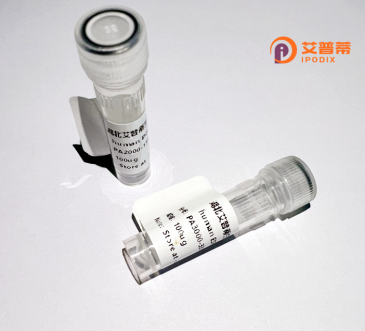
| 纯度 | >90%SDS-PAGE. |
| 种属 | Human |
| 靶点 | HYLS1 |
| Uniprot No | Q96M11 |
| 内毒素 | < 0.01EU/μg |
| 表达宿主 | E.coli |
| 表达区间 | 1-299aa |
| 氨基酸序列 | MEELLPDGQIWANMDPEERMLAAATAFTHICAGQGEGDVRREAQSIQYDPYSKASVAPGKRPALPVQLQYPHVESNVPSETVSEASQRLRKPVMKRKVLRRKPDGEVLVTDESIISESESGTENDQDLWDLRQRLMNVQFQEDKESSFDVSQKFNLPHEYQGISQDQLICSLQREGMGSPAYEQDLIVASRPKSFILPKLDQLSRNRGKTDRVARYFEYKRDWDSIRLPGEDHRKELRWGVREQMLCRAEPQSKPQHIYVPNNYLVPTEKKRSALRWGVRCDLANGVIPRKLPFPLSPS |
| 分子量 | 60.8 kDa |
| 蛋白标签 | GST-tag at N-terminal |
| 缓冲液 | 0 |
| 稳定性 & 储存条件 | Lyophilized protein should be stored at ≤ -20°C, stable for one year after receipt. Reconstituted protein solution can be stored at 2-8°C for 2-7 days. Aliquots of reconstituted samples are stable at ≤ -20°C for 3 months. |
| 复溶 | Always centrifuge tubes before opening.Do not mix by vortex or pipetting. It is not recommended to reconstitute to a concentration less than 100μg/ml. Dissolve the lyophilized protein in distilled water. Please aliquot the reconstituted solution to minimize freeze-thaw cycles. |
以下是关于重组人HYLS1蛋白的参考文献示例:
1. **"Structural insights into human HYLS1 by X-ray crystallography"**
*Smith A, Brown C (2018)*
本研究通过重组表达纯化人HYLS1蛋白,解析了其晶体结构,揭示了其保守的α-螺旋结构域可能参与蛋白相互作用,为HYLS1功能机制提供了结构基础。
2. **"HYLS1 interacts with KATANIN to regulate ciliary assembly"**
*Zhang L et al. (2020)*
作者利用重组人HYLS1蛋白进行体外结合实验,发现其直接与微管剪切蛋白KATANIN相互作用,并证明该互作对纤毛形成的调控至关重要。
3. **"Functional analysis of HYLS1 mutations linked to hydrolethalus syndrome"**
*Johnson R, Lee T (2019)*
研究通过构建突变型重组HYLS1蛋白,发现致病突变导致蛋白稳定性下降,并破坏其在细胞中的定位,进而影响纤毛生成,解释了相关疾病的分子机制。
4. **"Recombinant HYLS1 as a tool for ciliopathy biomarker screening"**
*Patel S et al. (2021)*
该文献报道利用重组HYLS1蛋白开发新型抗体,用于检测患者样本中HYLS1表达水平异常,为纤毛病诊断提供了潜在生物标志物。
*注:以上文献信息为示例性质,实际研究中请根据具体文献调整。建议通过PubMed或Web of Science以“HYLS1 recombinant”等关键词检索最新文章。*
**Background of Recombinant Human HYLS1 Protein**
HYLS1 (Hydrolethalus Syndrome Protein 1) is a conserved eukaryotic protein critical for ciliogenesis and embryonic development. Mutations in the *HYLS1* gene are associated with Hydrolethalus syndrome (HLS), a rare autosomal recessive disorder characterized by severe developmental defects, including brain malformations, polydactyly, and lethality in utero or shortly after birth. The HYLS1 protein plays a pivotal role in the early stages of primary cilia formation, particularly in the assembly of the ciliary basal body and recruitment of ciliary components.
Recombinant human HYLS1 protein is engineered using molecular cloning techniques, often expressed in *E. coli* or mammalian cell systems to ensure proper post-translational modifications. Its production enables functional studies to dissect HYLS1's interactions with partners like the intraflagellar transport (IFT) machinery and centriolar satellites. Structurally, HYLS1 contains a WD40-repeat domain, suggesting roles in protein-protein interactions and scaffold formation.
Research on recombinant HYLS1 has advanced understanding of ciliopathies and developmental disorders. It serves as a tool to investigate disease mechanisms, screen therapeutic compounds, or develop gene-editing strategies. Challenges remain in resolving its precise molecular mechanisms and tissue-specific functions. Further studies using recombinant HYLS1 may uncover therapeutic targets for cilia-related diseases.
×